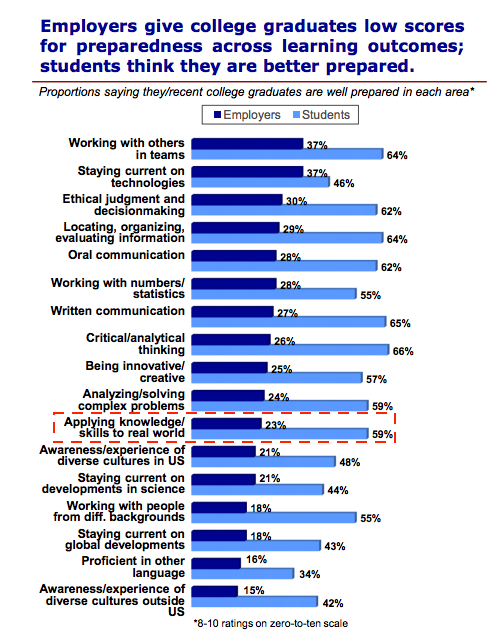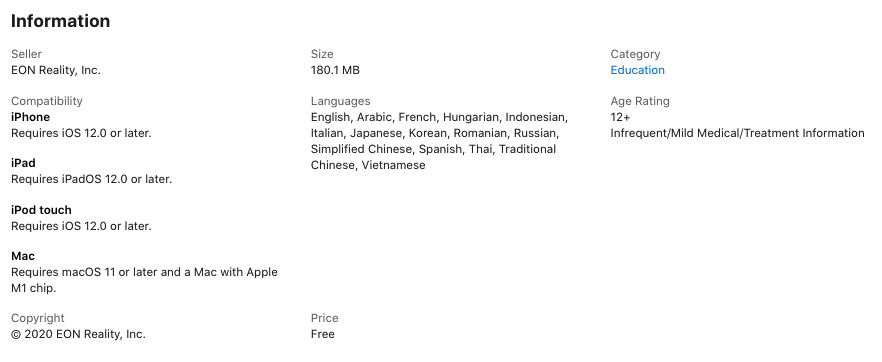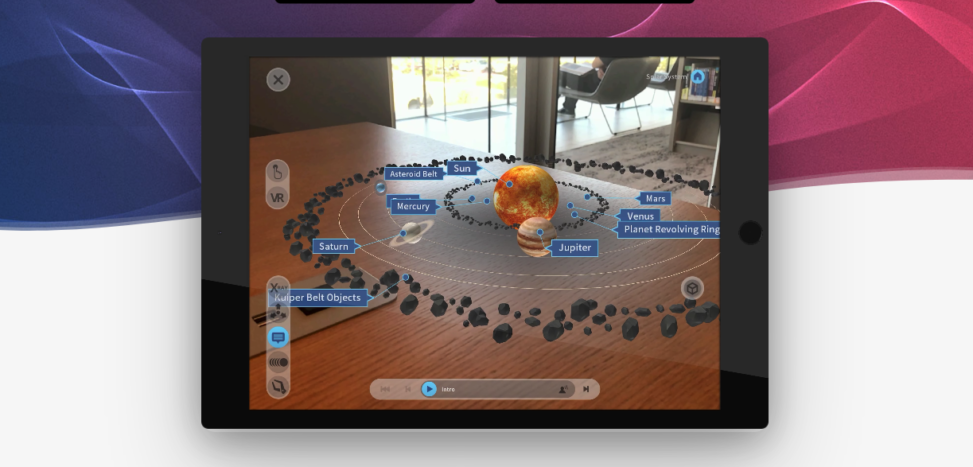Introduction
The AVR platform, also called EON-XR, is an Augmented and Virtual Reality media platform designed for anyone without coding knowledge to create AR and VR lessons. The platform contains a wide range of AVR applications, including 3D and 360 assets, covering almost every subject in the K12 secondary and higher education context. In the AVR library, users have access to 870,000 3D assets. In this report, we will mainly focus on their 3D assets with the application of AR and VR.
Instructor Perspective
Ease of Use
The user interface of the AVR platform is easy to use for students and teachers. Smart device users can interact with the 3D models by touching the screen, which is more cost-efficient as it requires no virtual reality devices. In addition, users can choose to view in Virtual Reality (via a VR device) or Augmented Reality by placing the content on a flat surface through the camera. For PC users, they need to install the software in order to manipulate the 3D models, and the software does not support interactions in VR or AR due to the limitation of PC devices.
Another advantage is that the user’s and creator’s interface follow the same pattern, which means that a “mature” user can also be a potential lesson-creator. Based on the features mentioned above, creating a VR and AR lesson using EON-XR seems like designing an infographic and requires no advanced technical skill and devices.
Supporting Pedagogy and Academic Writing on the Educational Benefits
Before we dive into the AVR platform’s educational use, let’s briefly discuss its educational benefits stated by scholars and AVR experts. The AVR platform implication can avoid the pitfall of memorized-procedure-and-fact course exams that fail to measure the understanding of flexible, practical knowledge in a relevant situation (Wieman, 2015, 01:57). The Hart Research Associates survey in 2015 (Fig. 1) showed a significant difference in expectation from students and employers in terms of preparedness for working in the real world (AACU Survey, 2015, p. 12). According to Stenger (2017), the possible reason for this is that “memory is context dependent, so transferring or recalling something that was learned in a classroom setting to a fast-paced work environment isn’t always easy.”

Fig. 1
Immersive VR learning is created to solve the issues. Compared with the traditional physical interface, a three-dimensional hologram (3DH) can provide users with a more on-the-spot experience and integrate with the real environment (Ngiik-Hoon & Shukhaila, p. 1037). Research also finds that “AR delivered almost double (1.9 times) the levels of visual attention compared to the non-AR equivalent,” and the memory encoding activity was 70% higher in the AR tasks compared to the non-AR tasks (Andrew, 2018).
Here is a short video that demonstrates how Augmented Reality affects the brain:
Zappar. (2018). How augmented reality affects the brain | Mindshare UK & Zappar [Video]. YouTube. https://www.youtube.com/watch?v=mxvfSF60ujE
Although immersive VR and AR learning seems promising, some teachers resist digital media adoption in K-12 arts education because they consider digital media irrelevant to the existing curriculum (Song, p. 690). Now let’s talk about how the AVR platform supports pedagogy. First, every asset in the library is a pedagogically-sound lesson. Teachers can choose to create their lessons based on the provided models with minimal modification. Second, features like adding contextual information, audio narrations, videos, and quizzes also support teaching. Ultimately, they offer school accounts to institutions, including teacher and student accounts, which enables corporations and lesson distributions. Up to now, they have many academic customers and partners (Fig. 2).

Fig.2
Accessibility and UDL
The AVR platform is available on Android or iOS for both phones and tablets. For each lesson, the audio is attached with readings. Relating to UDL principles imparted by CAST (2018), the platform is designed to assist educators in creating accessible learning experiences:
Multiple means of Engagement: AR and VR increase the levels of visual attention and enhance the learning transfer from textbook knowledge to the real working environment.
Multiple means of representation: Students have alternatives of how they want to interact with the learning content. Either through AV or VR. Textual information, audio, and video are also available.
Multiple means of action and expression: Similarly, when students create a project, they can also choose how they want to present their understanding of the content.
Considering the accessibility, we will use the POUR model to analyze the platform.
Perceivable: It still does not have interface with screen readers, making them inaccessible to students with visual impairment.
Operable: Smart devices users have better learning experience than PC users. There is limited information on assistive technology support.
Understandable: The interface is well-designed and easy to follow and contains no extraneous information. Student cognitive overload is avoided.
Robust: It is compatible with most operating systems and works well on most devices. As the information presented in Fig 3, it is only available for iOS 12.0, which denies older version users.

Fig. 3
Student Perspective
Suitability for individual student and group use
Interacting with the high-quality 3D models enhances learning experience. Students can also choose to learn anywhere and anytime with an Internet connection. Given the current Pandemic crisis, the platform allows students to learn in a virtual lab with limited in-person contact. Moreover, it supports group use with school account purchased. With the teacher accounts, teachers can monitor students’ progress and provide instant feedback.
Appropriateness for project-based learning
AVR platform can foster student inquiry and promote student autonomy, which is essential for project-based learning. Students can work on the assigned project by modifying or designing their AR or VR presentation. There is a wide range of 3D assets in the library to choose from for any discipline. Students can decide on using texts, audios, or videos in their project. Videos can also be directly imported from video repositories like YouTube.
Questions
When looking at the AVR platform, do you think you can use it in your class?
Could the virtual lab simulation replace the laboratory during the pandemic or even in the future?
What is the limitation of using the AVR platform in your teaching area or the educational context you support?
Presentation video by Jason Purdy & Junxiang Zhang (Team 8)
Resources
The official login page: https://account.eon-xr.com/Home/IndexV2
Feel free to use my account to try out the platform:
Email: zhangj199@mytru.ca
Password: 123456asdf
AVR Platform Quick Start Guide – Personal Computers
AVR Platform Quick Start Guide – Mobile Devices
References
Andrew, H. (2018, May 24). How augmented reality affects the brain.
CAST. (2018). The UDL guidelines (version 2.2). http://udlguidelines.cast.org/
EON Reality. (2020, August 18). Become an expert at creating AR / VR lessons with these 5 videos. https://eonreality.com/expert-at-creating-ar-and-vr-lessons/
EON Reality. (2020). AVR Platform Quick Start Guide – Mobile Devices [Video]. YouTube. https://www.youtube.com/watch?v=aj1DLUvlXrk
EON Reality. (2020). AVR Platform Quick Start Guide – Personal Computers [Video]. YouTube. https://www.youtube.com/watch?v=3I_qo9z00-0
Hart Research Associates. (2015). Falling Short? College Learning and Career Success. https://www.aacu.org/sites/default/files/files/LEAP/2015employerstudentsurvey.pdf
Ngiik-Hoon Loh, & Siti Shukhaila Bt Shaharuddin. (2019). Corporate Social Responsibility (Csr) Towards Education: The Application and Possibility of 3D Hologram to Enhance Cognitive Skills of Primary School Learners. International Journal of Business & Society, 20(3), 1036–1047.
Song, M. J. (2020). The application of digital fabrication technologies to the art and design curriculum in a teacher preparation program: a case study. International Journal of Technology & Design Education, 30(4), 687–707. https://doi.org/10.1007/s10798-019-09524-6
Stenger, M. (2017, May 11). 10 ways to improve transfer of learning. InformED. https://www.opencolleges.edu.au/informed/features/10-ways-improve-transfer-learning/
W3C. (2004). Overview of design principles. Web Content Accessibility Guidelines 2.0 Working Draft.
https://www.w3.org/2004/10/wcag2-nav/wcag20princ.html
Wieman, C. (2015, November 3). Finding New Ways to Learn Science – Carl Wieman [Video]. YouTube. https://www.youtube.com/watch?v=oIpcZbAmDOY
Zappar. (2018). How augmented reality affects the brain | Mindshare UK & Zappar [Video]. YouTube. https://www.youtube.com/watch?v=mxvfSF60ujE
Zappar. https://www.zappar.com/blog/how-augmented-reality-affects-brain/


Gulia Iamaleeva
Hi Jason and Junxiang. Thank you for sharing the tool. It looks really cool. I was trying to google and find it to try myself, but wasn’t able to locate a website allows to download it. Would you be able to provide a link?
Junxiang
Hello Gulia,
Thanks for your comments. For PC users, we need to login to the EON-XR (the link: https://account.eon-xr.com/Home/IndexV2) first and then click Downloads under the My Account. There should be options for Windows or macOS. (The PC version has more limitations than the mobile device version)
I have attached two starting tutorial in our blogs. I hope it helps. Thanks for your feedback!
Junxiang
Paul Chong
Hi Jun and Jason,
Thank you for sharing this alternative media platform that is probably unfamiliar to many of us. Very cool!
Questions
When looking at the AVR platform, do you think you can use it in your class?
I did a quick search on the website and found some very cool lessons. Though I didn’t dive through the sign up process, there was a relatable science safety VR activity (https://eonreality.com/use-case/remote-learning-vr-laboratory/). Though science classrooms don’t typically look like this, you can still use it as a teaching tool to talk about general lab safety.
Could the virtual lab simulation replace the laboratory during the pandemic or even in the future?
I think that VR definitely has the potential to replace a lot of learning that can happen in the future. Once it becomes better developed, accessible, and easy to use, I can see a future where, in some contexts and scenarios, VR lab simulations would be preferred (costs of materials, space in a classroom, and other factors). However, with that in mind, nothing can replace real-life interactions and labs.
What is the limitation of using the AVR platform in your teaching area or the educational context you support?
I think currently, the biggest limitation of AVR platforms in my teaching areas is accessibility, knowledge/training, and time. Firstly, though most students do have devices, not everyone has compatible or up-to-date devices that would be powerful enough to run the AVR platform. Though sharing is possible, there may be some missed learning opportunities there. There would be time also needed to support and help students navigate the platform. Additionally, lots of time needed as an educator to develop meaningful learning opportunities around AVR platforms.
Junxiang
Hi Paul,
I’m glad you noticed their virtual laboratory. Indeed, it might need some advancement. I agree with the limitations you mentioned. Although it is compatible with most devices, it still requires a comparatively new version of the operating system. It will cost a lot if schools decide to buy the software and the relevant devices. It may explain why most of their academic partners are institutions of higher education.
Thanks for your thoughts and sharing!
bgilligan
I do believe that it has a place in K-12 education and specifically in visual arts, especially as many of the bigger museums are advancing with AR at the very least. The medium has changed significantly from the time I had very limited experience with Second Life and its educational outlets (mechanics is the one I remember). I think my biggest drawback would be the resources needed to access the system effectively at my particular grade level, but it looks as if that may become a moot point in the short term as technology advances further.
Keisha Morong
Hi Jason and Junxiang,
Firstly, I really enjoyed your report/post. I really appreciate your use of video and graphics to help us understand the use and importance of a tool such as the AVR Platform. The walkthrough in your presentation was also super cool.
I appreciate that you mentioned early on that the platform can be used even by “mature” users and does not require advanced technical skills. My fear of new technology kicked in as soon as I started reading about the platform and I think this answers two of the questions you asked us. Can AVR be used at our institution? Yes, of course! We just completed a virtual open house today that proves how much higher education needs to learn more about using AVR with our students. However, you ask what is one of the barriers of use, and it’s my fear, and the fear of many of those that aren’t familiar with a lot of these newer tools. The time and energy required to explore and develop the knowledge of using a tool like AVR is something instructors need to be self-motivated to put in, and this can be a real barrier.
Very cool tool. Thanks!